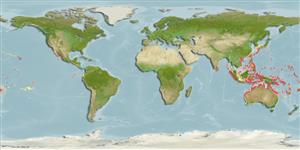>
Blenniiformes (Blennies) >
Tripterygiidae (Triplefin blennies) > Tripterygiinae
Etymology: Enneapterygius: Greek, ennea = nine times + Greek, pterygion = little fin (Ref. 45335).
Environment: milieu / climate zone / depth range / distribution range
Écologie
marin récifal; profondeur 0 - 22 m (Ref. 27223). Tropical
Western Central Pacific.
Taille / Poids / Âge
Maturity: Lm ? range ? - ? cm
Max length : 3.2 cm TL mâle / non sexé; (Ref. 90102)
Description synthétique
Clés d'identification | Morphologie | Morphométrie
Épines dorsales (Total) : 14 - 15; Rayons mous dorsaux (Total) : 8 - 10; Épines anales: 1; Rayons mous anaux: 17 - 18. Male dark grey with large yellow patch dorsally on head, and lower head and pectoral-fin base black. Female tan with 5 double brown bars on side. Both sexes with black bar at caudal-fin base preceded by white bar/saddle. Dorsal rays III + XI-XII + 8-10; anal rays I,17-18; pectoral rays 14-17; pelvic rays I,2; lateral line interrupted 15-17 + 17-22; head, chest, and pectoral-fin base scaleless; short orbital tentacle present; mandibular pores 3 + 1 + 3. Maximum size to 3.2 cm TL (Ref. 90102).
Adults occur on rocky substrates in association with coral reefs or coral reef lagoons, from shallow areas to the outer reef slope, also in intertidal rock pools (Ref. 13227, 27223). Eggs are hemispherical and covered with numerous sticky threads that anchor them in the algae on the nesting sites (Ref. 240). Larvae are planktonic which occur primarily in shallow, nearshore waters (Ref. 94114).
Life cycle and mating behavior
Maturities | Reproduction | Spawnings | Egg(s) | Fecundities | Larves
Springer, V.G. and T.M. Orrell, 1996. Catalog of type specimens of recent fishes in the National Museum of Natural History, Smithsonian Institution, 5: Chaenopsidae, Clinidae, Dactyloscopidae, Labrisomidae, and Tripterygiidae. Smithson. Contrib. Zool. 576:38. (Ref. 13293)
Statut dans la liste rouge de l'IUCN (Ref. 130435)
Menace pour l'homme
Harmless
Utilisations par l'homme
Outils
Articles particuliers
Télécharger en XML
Sources Internet
Estimates based on models
Preferred temperature (Ref.
123201): 24.7 - 29.3, mean 28.5 °C (based on 2149 cells).
Phylogenetic diversity index (Ref.
82804): PD
50 = 0.5000 [Uniqueness, from 0.5 = low to 2.0 = high].
Bayesian length-weight: a=0.00562 (0.00258 - 0.01228), b=3.08 (2.89 - 3.27), in cm total length, based on LWR estimates for this (Sub)family-body shape (Ref.
93245).
Niveau trophique (Ref.
69278): 3.1 ±0.3 se; based on size and trophs of closest relatives
Résilience (Ref.
120179): Haut, temps minimum de doublement de population inférieur à 15 mois (Preliminary K or Fecundity.).
Fishing Vulnerability (Ref.
59153): Low vulnerability (10 of 100).
Nutrients (Ref.
124155): Calcium = 636 [181, 3,816] mg/100g; Iron = 3.46 [0.93, 9.61] mg/100g; Protein = 18.1 [15.9, 20.2] %; Omega3 = 0.098 [0.016, 0.665] g/100g; Selenium = 104 [12, 665] μg/100g; VitaminA = 23.6 [1.9, 282.4] μg/100g; Zinc = 7.75 [2.73, 17.14] mg/100g (wet weight);
